Tigecycline
Editor-In-Chief: C. Michael Gibson, M.S., M.D. [1]; Associate Editor(s)-in-Chief: Gloria Picoy [2]
Disclaimer
WikiDoc MAKES NO GUARANTEE OF VALIDITY. WikiDoc is not a professional health care provider, nor is it a suitable replacement for a licensed healthcare provider. WikiDoc is intended to be an educational tool, not a tool for any form of healthcare delivery. The educational content on WikiDoc drug pages is based upon the FDA package insert, National Library of Medicine content and practice guidelines / consensus statements. WikiDoc does not promote the administration of any medication or device that is not consistent with its labeling. Please read our full disclaimer here.
Overview
Tigecycline is an antibiotic that is FDA approved for the treatment of complicated skin and skin structure infections, complicated intra-abdominal infections and community-acquired pneumonia. Common adverse reactions include nausea, vomiting, diarrhea, abdominal pain, headache and increased SGPT.
Adult Indications and Dosage
FDA-Labeled Indications and Dosage (Adult)
Complicated Skin and Skin Structure Infections
Caused by Escherichia coli, Enterococcus faecalis (vancomycin-susceptible isolates), Staphylococcus aureus (methicillin-susceptible and -resistant isolates), Streptococcus agalactiae, Streptococcus anginosus grp. (includes S. anginosus, S. intermedius, and S. constellatus), Streptococcus pyogenes, Enterobacter cloacae, Klebsiella pneumoniae, and Bacteroides fragilis.
- Dosage:
- Initial dose of 100 mg
- Followed by 50 mg every 12 hours
- Intravenous infusions of tigecycline should be administered over approximately 30 to 60 minutes every 12 hours.
- Duration of treatment is 5 to 14 days.
Complicated Intra-abdominal Infections
Caused by Citrobacter freundii, Enterobacter cloacae, Escherichia coli, Klebsiella oxytoca, Klebsiella pneumoniae, Enterococcus faecalis (vancomycin-susceptible isolates), Staphylococcus aureus (methicillin-susceptible and -resistant isolates), Streptococcus anginosus grp. (includes S. anginosus, S. intermedius, and S. constellatus), Bacteroides fragilis, Bacteroides thetaiotaomicron, Bacteroides uniformis, Bacteroides vulgatus, Clostridium perfringens, and Peptostreptococcus micros.
- Dosage:
- Initial dose of 100 mg
- Followed by 50 mg every 12 hours
- Intravenous infusions of tigecycline should be administered over approximately 30 to 60 minutes every 12 hours.
- Duration of treatment is 5 to 14 days.
Community-acquired pneumonia
Caused by Streptococcus pneumoniae (penicillin-susceptible isolates), including cases with concurrent bacteremia, Haemophilus influenzae (beta-lactamase negative isolates), and Legionella pneumophila.
- Dosage:
- Initial dose of 100 mg
- Followed by 50 mg every 12 hours
- Intravenous infusions of tigecycline should be administered over approximately 30 to 60 minutes every 12 hours.
- Duration of treatment is 7 to 14 days.
Off-Label Use and Dosage (Adult)
Guideline-Supported Use
There is limited information regarding Off-Label Guideline-Supported Use of Tigecycline in adult patients.
Non–Guideline-Supported Use
There is limited information regarding Off-Label Non–Guideline-Supported Use of Tigecycline in adult patients.
Pediatric Indications and Dosage
FDA-Labeled Indications and Dosage (Pediatric)
The safety and efficacy of the proposed pediatric dosing regimens have not been evaluated due to the observed increase in mortality associated with tigecycline in adult patients. Tigecycline should not be used in pediatric patients unless no alternative antibacterial drugs are available. Under these circumstances, the following doses are suggested:
- Pediatric patients aged 8 to 11 years should receive 1.2 mg/kg of tigecycline every 12 hours intravenously to a maximum dose of 50 mg of tigecycline every 12 hours.
- Pediatric patients aged 12 to 17 years should receive 50 mg of tigecycline every 12 hours,
Off-Label Use and Dosage (Pediatric)
Guideline-Supported Use
There is limited information regarding Off-Label Guideline-Supported Use of Tigecycline in pediatric patients.
Non–Guideline-Supported Use
There is limited information regarding Off-Label Non–Guideline-Supported Use of Tigecycline in pediatric patients.
Contraindications
- Tigecycline is contraindicated for use in patients who have known hypersensitivity to tigecycline.
Warnings
All-Cause Mortality
- An increase in all-cause mortality has been observed in a meta-analysis of Phase 3 and 4 clinical trials in tigecycline-treated patients versus comparator-treated patients. In all 13 Phase 3 and 4 trials that included a comparator, death occurred in 4.0% (150/3788) of patients receiving tigecycline and 3.0% (110/3646) of patients receiving comparator drugs. In a pooled analysis of these trials, based on a random effects model by trial weight, the adjusted risk difference of all-cause mortality was 0.6% (95% CI 0.1, 1.2) between tigecycline and comparator-treated patients. An analysis of mortality in all trials conducted for approved indications (cSSSI, cIAI, and CABP), including post-market trials showed an adjusted mortality rate of 2.5% (66/2640) for tigecycline and 1.8% (48/2628) for comparator, respectively. The adjusted risk difference for mortality stratified by trial weight was 0.6% (95% CI 0.0, 1.2).
- The cause of this mortality difference has not been established. Generally, deaths were the result of worsening infection, complications of infection or underlying co-morbidities. tigecycline should be reserved for use in situations when alternative treatments are not suitable.
Mortality Imbalance and Lower Cure Rates in Hospital-Acquired Pneumonia
- A trial of patients with hospital acquired, including ventilator-associated, pneumonia failed to demonstrate the efficacy of tigecycline. In this trial, patients were randomized to receive tigecycline (100 mg initially, then 50 mg every 12 hours) or a comparator. In addition, patients were allowed to receive specified adjunctive therapies. The sub-group of patients with ventilator-associated pneumonia who received tigecycline had lower cure rates (47.9% versus 70.1% for the clinically evaluable population).
- In this trial, greater mortality was seen in patients with ventilator-associated pneumonia who received tigecycline (25/131 [19.1%] versus 15/122 [12.3%] in comparator-treated patients). Particularly high mortality was seen among tigecycline-treated patients with ventilator-associated pneumonia and bacteremia at baseline (9/18 [50.0%] versus 1/13 [7.7%] in comparator-treated patients).
Anaphylaxis/Anaphylactoid Reactions
- Anaphylaxis/anaphylactoid reactions have been reported with nearly all antibacterial agents, including tigecycline, and may be life-threatening. tigecycline is structurally similar to tetracycline-class antibiotics and should be administered with caution in patients with known hypersensitivity to tetracycline-class antibiotics.
Hepatic Effects
- Increases in total bilirubin concentration, prothrombin time and transaminases have been seen in patients treated with tigecycline. Isolated cases of significant hepatic dysfunction and hepatic failure have been reported in patients being treated with tigecycline. Some of these patients were receiving multiple concomitant medications. Patients who develop abnormal liver function tests during tigecycline therapy should be monitored for evidence of worsening hepatic function and evaluated for risk/benefit of continuing tigecycline therapy. Adverse events may occur after the drug has been discontinued.
Pancreatitis
- Acute pancreatitis, including fatal cases, has occurred in association with tigecycline treatment. The diagnosis of acute pancreatitis should be considered in patients taking tigecycline who develop clinical symptoms, signs, or laboratory abnormalities suggestive of acute pancreatitis. Cases have been reported in patients without known risk factors for pancreatitis. Patients usually improve after tigecycline discontinuation. Consideration should be given to the cessation of the treatment with tigecycline in cases suspected of having developed pancreatitis.
Use During Pregnancy
- Tigecycline may cause fetal harm when administered to a pregnant woman. If the patient becomes pregnant while taking tigecycline, the patient should be apprised of the potential hazard to the fetus. Results of animal studies indicate that tigecycline crosses the placenta and is found in fetal tissues. Decreased fetal weights in rats and rabbits (with associated delays in ossification) and fetal loss in rabbits have been observed with tigecycline.
Tooth Development
- The use of tigecycline during tooth development (last half of pregnancy, infancy, and childhood to the age of 8 years) may cause permanent discoloration of the teeth (yellow-gray-brown). Results of studies in rats with tigecycline have shown bone discoloration. tigecycline should not be used during tooth development unless other drugs are not likely to be effective or are contraindicated.
Clostridium difficile Associated Diarrhea
- Clostridium difficile associated diarrhea (CDAD) has been reported with use of nearly all antibacterial agents, including tigecycline, and may range in severity from mild diarrhea to fatal colitis. Treatment with antibacterial agents alters the normal flora of the colon leading to overgrowth of C. difficile.
- C. difficile produces toxins A and B which contribute to the development of CDAD. Hypertoxin producing strains of C. difficile cause increased morbidity and mortality, as these infections can be refractory to antimicrobial therapy and may require colectomy. CDAD must be considered in all patients who present with diarrhea following antibiotic use. Careful medical history is necessary since CDAD has been reported to occur over two months after the administration of antibacterial agents.
- If CDAD is suspected or confirmed, ongoing antibiotic use not directed against C. difficile may need to be discontinued. Appropriate fluid and electrolyte management, protein supplementation, antibiotic treatment of C. difficile, and surgical evaluation should be instituted as clinically indicated.
Patients With Intestinal Perforation
- Caution should be exercised when considering tigecycline monotherapy in patients with complicated intra-abdominal infections (cIAI) secondary to clinically apparent intestinal perforation. In cIAI studies (n=1642), 6 patients treated with tigecycline and 2 patients treated with imipenem/cilastatin presented with intestinal perforations and developed sepsis/septic shock. The 6 patients treated with tigecycline had higher APACHE II scores (median = 13) versus the 2 patients treated with imipenem/cilastatin (APACHE II scores = 4 and 6). Due to differences in baseline APACHE II scores between treatment groups and small overall numbers, the relationship of this outcome to treatment cannot be established.
Tetracycline-Class Effects
- tigecycline is structurally similar to tetracycline-class antibiotics and may have similar adverse effects. Such effects may include: photosensitivity, pseudotumor cerebri, and anti-anabolic action (which has led to increased BUN, azotemia, acidosis, and hyperphosphatemia). As with tetracyclines, pancreatitis has been reported with the use of TYGACI.
Superinfection
- As with other antibacterial drugs, use of tigecycline may result in overgrowth of non-susceptible organisms, including fungi. Patients should be carefully monitored during therapy. If superinfection occurs, appropriate measures should be taken.
Development of Drug-Resistant Bacteria
- Prescribing tigecycline in the absence of a proven or strongly suspected bacterial infection is unlikely to provide benefit to the patient and increases the risk of the development of drug-resistant bacteria.
Adverse Reactions
Clinical Trials Experience
Because clinical trials are conducted under widely varying conditions, adverse reaction rates observed in the clinical trials of a drug cannot be directly compared to rates in the clinical trials of another drug and may not reflect the rates observed in practice.
In clinical trials, 2514 patients were treated with tigecycline. tigecycline was discontinued due to adverse reactions in 7% of patients compared to 6% for all comparators. Table 1 shows the incidence of treatment-emergent adverse reactions through test of cure reported in ≥2% of patients in these trials.
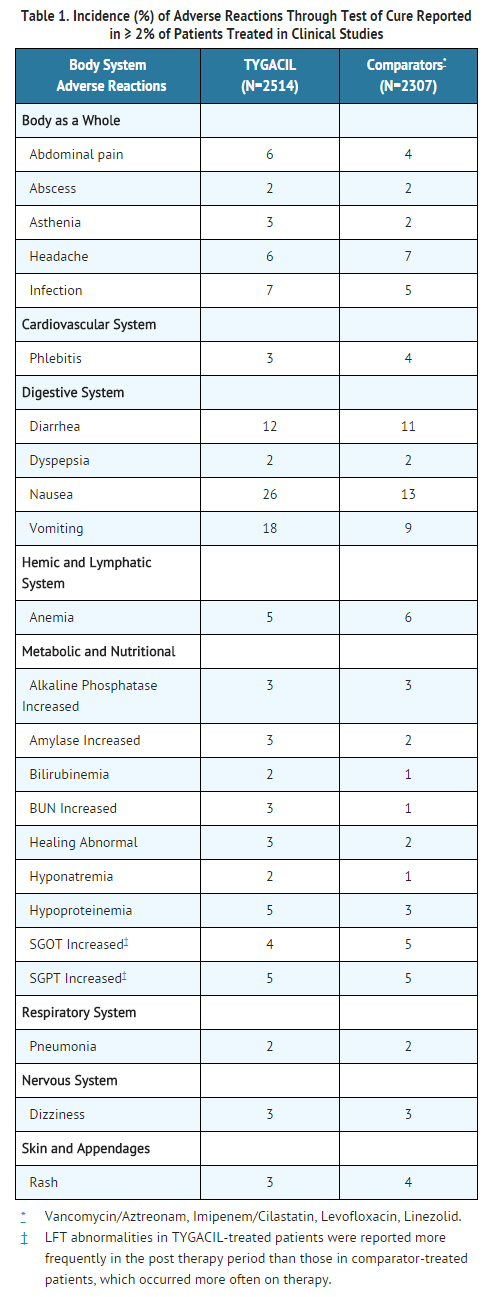
In all 13 Phase 3 and 4 trials that included a comparator, death occurred in 4.0% (150/3788) of patients receiving tigecycline and 3.0% (110/3646) of patients receiving comparator drugs. In a pooled analysis of these trials, based on a random effects model by trial weight, an adjusted risk difference of all-cause mortality was 0.6% (95% CI 0.1, 1.2) between tigecycline and comparator-treated patients. The cause of the imbalance has not been established. Generally, deaths were the result of worsening infection, complications of infection or underlying co-morbidities.
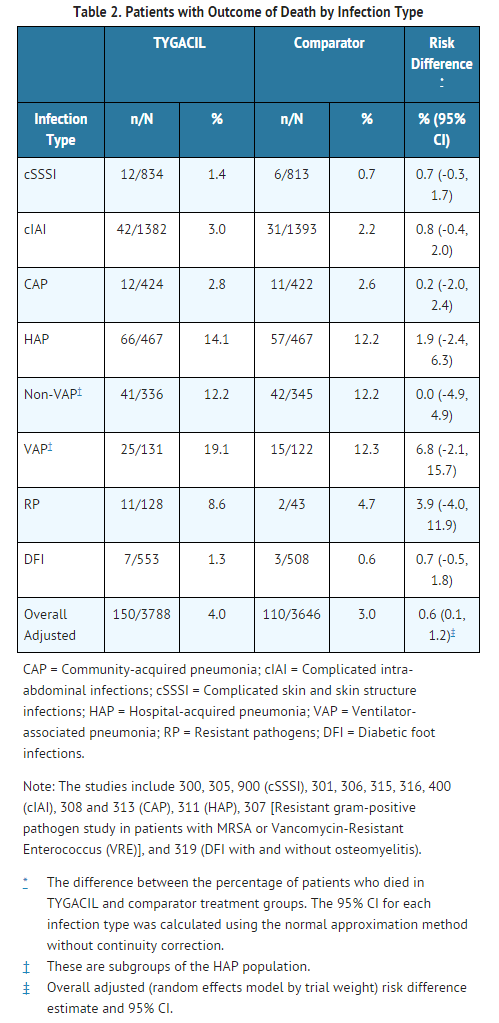
An analysis of mortality in all trials conducted for approved indications - cSSSI, cIAI, and CABP, including post-market trials (315, 400, 900) - showed an adjusted mortality rate of 2.5% (66/2640) for tigecycline and 1.8% (48/2628) for comparator, respectively. The adjusted risk difference for mortality stratified by trial weight was 0.6% (95% CI 0.0, 1.2).
In comparative clinical studies, infection-related serious adverse events were more frequently reported for subjects treated with tigecycline (7%) versus comparators (6%). Serious adverse events of sepsis/septic shock were more frequently reported for subjects treated with tigecycline (2%) versus comparators (1%). Due to baseline differences between treatment groups in this subset of patients, the relationship of this outcome to treatment cannot be established.
The most common treatment-emergent adverse reactions were nausea and vomiting which generally occurred during the first 1 – 2 days of therapy. The majority of cases of nausea and vomiting associated with tigecycline and comparators were either mild or moderate in severity. In patients treated with tigecycline, nausea incidence was 26% (17% mild, 8% moderate, 1% severe) and vomiting incidence was 18% (11% mild, 6% moderate, 1% severe).
In patients treated for complicated skin and skin structure infections (cSSSI), nausea incidence was 35% for tigecycline and 9% for vancomycin/aztreonam; vomiting incidence was 20% for tigecycline and 4% for vancomycin/aztreonam. In patients treated for complicated intra-abdominal infections (cIAI), nausea incidence was 25% for tigecycline and 21% for imipenem/cilastatin; vomiting incidence was 20% for tigecycline and 15% for imipenem/cilastatin. In patients treated for community-acquired bacterial pneumonia (CABP), nausea incidence was 24% for tigecycline and 8% for levofloxacin; vomiting incidence was 16% for tigecycline and 6% for levofloxacin.
Discontinuation from tigecycline was most frequently associated with nausea (1%) and vomiting (1%). For comparators, discontinuation was most frequently associated with nausea (<1%).
The following adverse reactions were reported infrequently (<2%) in patients receiving tigecycline in clinical studies:
- Body as a Whole: injection site inflammation, injection site pain, injection site reaction, septic shock, allergic reaction, chills, injection site edema, injection site phlebitis
- Cardiovascular System: thrombophlebitis
- Digestive System: anorexia, jaundice, abnormal stools
- Metabolic/Nutritional System: increased creatinine, hypocalcemia, hypoglycemia
- Special Senses: taste perversion
- Hemic and Lymphatic System: partial thromboplastin time (aPTT), prolonged prothrombin time (PT), eosinophilia, increased international normalized ratio (INR), thrombocytopenia
- Skin and Appendages: pruritus
- Urogenital System: vaginal moniliasis, vaginitis, leukorrhea
Postmarketing Experience
The following adverse reactions have been identified during post-approval use of tigecycline. Because these reactions are reported voluntarily from a population of uncertain size, it is not always possible to reliably estimate their frequency or establish causal relationship to drug exposure.
- anaphylaxis/anaphylactoid reactions
- acute pancreatitis
- hepatic cholestasis, and jaundice
- severe skin reactions, including Stevens-Johnson Syndrome
- symptomatic hypoglycemia in patients with and without diabetes mellitus
Drug Interactions
Warfarin
- Prothrombin time or other suitable anticoagulation test should be monitored if tigecycline is administered with warfarin.
Oral Contraceptives
- Concurrent use of antibacterial drugs with oral contraceptives may render oral contraceptives less effective.
Use in Specific Populations
Pregnancy
Pregnancy Category (FDA): D Tigecycline was not teratogenic in the rat or rabbit. In preclinical safety studies, 14C-labeled tigecycline crossed the placenta and was found in fetal tissues, including fetal bony structures. The administration of tigecycline was associated with reductions in fetal weights and an increased incidence of skeletal anomalies (delays in bone ossification) at exposures of 5 times and 1 times the human daily dose based on AUC in rats and rabbits, respectively (28 mcg∙hr/mL and 6 mcg∙hr/mL at 12 and 4 mg/kg/day). An increased incidence of fetal loss was observed at maternotoxic doses in the rabbits with exposure equivalent to human dose.
There are no adequate and well-controlled studies of tigecycline in pregnant women. tigecycline should be used during pregnancy only if the potential benefit justifies the potential risk to the fetus.
Pregnancy Category (AUS): D
There is no Australian Drug Evaluation Committee (ADEC) guidance on usage of Tigecycline in women who are pregnant.
Labor and Delivery
There is no FDA guidance on use of Tigecycline during labor and delivery.
Nursing Mothers
Results from animal studies using 14C-labeled tigecycline indicate that tigecycline is excreted readily via the milk of lactating rats. Consistent with the limited oral bioavailability of tigecycline, there is little or no systemic exposure to tigecycline in nursing pups as a result of exposure via maternal milk.
It is not known whether this drug is excreted in human milk. Because many drugs are excreted in human milk, caution should be exercised when tigecycline is administered to a nursing woman.
Pediatric Use
Use in patients under 18 years of age is not recommended. Safety and effectiveness in pediatric patients below the age of 18 years have not been established. Because of the increased mortality observed in tigecycline-treated adult patients in clinical trials, pediatric trials of tigecycline to evaluate the safety and efficacy of tigecycline were not conducted.
In situations where there are no other alternative antibacterial drugs, pediatric dosing has been proposed based on data from pediatric pharmacokinetic studies.
Because of effects on tooth development, use in patients under 8 years of age is not recommended.
Geriatic Use
Of the total number of subjects who received tigecycline in Phase 3 clinical studies (n=2514), 664 were 65 and over, while 288 were 75 and over. No unexpected overall differences in safety or effectiveness were observed between these subjects and younger subjects, but greater sensitivity to adverse events of some older individuals cannot be ruled out.
No significant difference in tigecycline exposure was observed between healthy elderly subjects and younger subjects following a single 100 mg dose of tigecycline.
Gender
In a pooled analysis of 38 women and 298 men participating in clinical pharmacology studies, there was no significant difference in the mean (±SD) tigecycline clearance between women (20.7±6.5 L/h) and men (22.8±8.7 L/h). Therefore, no dosage adjustment is necessary based on gender.
Race
In a pooled analysis of 73 Asian subjects, 53 Black subjects, 15 Hispanic subjects, 190 White subjects, and 3 subjects classified as "other" participating in clinical pharmacology studies, there was no significant difference in the mean (±SD) tigecycline clearance among the Asian subjects (28.8±8.8 L/h), Black subjects (23.0±7.8 L/h), Hispanic subjects (24.3±6.5 L/h), White subjects (22.1±8.9 L/h), and "other" subjects (25.0±4.8 L/h). Therefore, no dosage adjustment is necessary based on race.
Renal Impairment
A single dose study compared 6 subjects with severe renal impairment (creatinine clearance <30 mL/min), 4 end stage renal disease (ESRD) patients receiving tigecycline 2 hours before hemodialysis, 4 ESRD patients receiving tigecycline 1 hour after hemodialysis, and 6 healthy control subjects. The pharmacokinetic profile of tigecycline was not significantly altered in any of the renally impaired patient groups, nor was tigecycline removed by hemodialysis. No dosage adjustment of tigecycline is necessary in patients with renal impairment or in patients undergoing hemodialysis.
Hepatic Impairment
No dosage adjustment is warranted in patients with mild to moderate hepatic impairment (Child Pugh A and Child Pugh B). In patients with severe hepatic impairment (Child Pugh C), the initial dose of tigecycline should be 100 mg followed by a reduced maintenance dose of 25 mg every 12 hours. Patients with severe hepatic impairment (Child Pugh C) should be treated with caution and monitored for treatment response.
Females of Reproductive Potential and Males
Tigecycline did not affect mating or fertility in rats at exposures up to 5 times the human daily dose based on AUC (28 mcg∙hr/mL at 12 mg/kg/day). In female rats, there were no compound-related effects on ovaries or estrous cycles at exposures up to 5 times the human daily dose based on AUC.
Immunocompromised Patients
There is no FDA guidance one the use of Tigecycline in patients who are immunocompromised.
Administration and Monitoring
Administration
Intravenous
Monitoring
There is limited information regarding Tigecycline Monitoring in the drug label.
IV Compatibility
There is limited information regarding the compatibility of Tigecycline and IV administrations.
Overdosage
No specific information is available on the treatment of overdosage with tigecycline. Intravenous administration of tigecycline at a single dose of 300 mg over 60 minutes in healthy volunteers resulted in an increased incidence of nausea and vomiting. In single-dose intravenous toxicity studies conducted with tigecycline in mice, the estimated median lethal dose (LD50) was 124 mg/kg in males and 98 mg/kg in females. In rats, the estimated LD50 was 106 mg/kg for both sexes. Tigecycline is not removed in significant quantities by hemodialysis.
Pharmacology
There is limited information regarding Tigecycline Pharmacology in the drug label.
Mechanism of Action
Tigecycline, a glycylcycline, inhibits protein translation in bacteria by binding to the 30S ribosomal subunit and blocking entry of amino-acyl tRNA molecules into the A site of the ribosome. This prevents incorporation of amino acid residues into elongating peptide chains. Tigecycline carries a glycylamido moiety attached to the 9-position of minocycline. The substitution pattern is not present in any naturally occurring or semisynthetic tetracycline and imparts certain microbiologic properties to tigecycline. In general, tigecycline is considered bacteriostatic; however, tigecycline has demonstrated bactericidal activity against isolates of S. pneumoniae and L. pneumophila.
Structure
- The empirical formula is C29H39N5O8 and the molecular weight is 585.65.
- The following represents the chemical structure of tigecycline:

Pharmacodynamics
Cardiac Electrophysiology
No significant effect of a single intravenous dose of tigecycline 50 mg or 200 mg on QTc interval was detected in a randomized, placebo- and active-controlled four-arm crossover thorough QTc study of 46 healthy subjects.
Pharmacokinetics
The mean pharmacokinetic parameters of tigecycline after single and multiple intravenous doses based on pooled data from clinical pharmacology studies are summarized in Table 3. Intravenous infusions of tigecycline were administered over approximately 30 to 60 minutes.
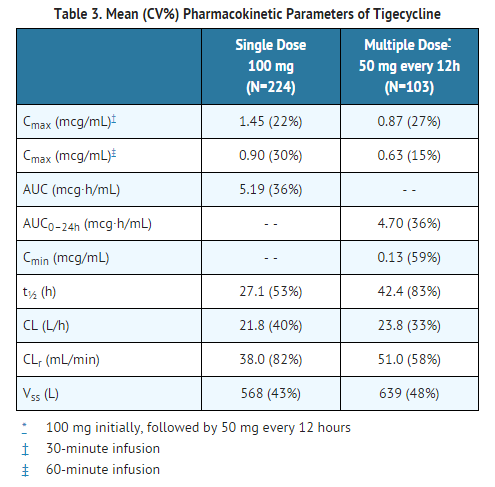
Distribution
The in vitro plasma protein binding of tigecycline ranges from approximately 71% to 89% at concentrations observed in clinical studies (0.1 to 1.0 mcg/mL). The steady-state volume of distribution of tigecycline averaged 500 to 700 L (7 to 9 L/kg), indicating tigecycline is extensively distributed beyond the plasma volume and into the tissues.
Following the administration of tigecycline 100 mg followed by 50 mg every 12 hours to 33 healthy volunteers, the tigecycline AUC0–12h (134 mcg∙h/mL) in alveolar cells was approximately 78-fold higher than the AUC0–12h in the serum, and the AUC0–12h (2.28 mcg∙h/mL) in epithelial lining fluid was approximately 32% higher than the AUC0–12h in serum. The AUC0–12h (1.61 mcg∙h/mL) of tigecycline in skin blister fluid was approximately 26% lower than the AUC0–12h in the serum of 10 healthy subjects.
In a single-dose study, tigecycline 100 mg was administered to subjects prior to undergoing elective surgery or medical procedure for tissue extraction. Concentrations at 4 hours after tigecycline administration were higher in gallbladder (38-fold, n=6), lung (3.7-fold, n=5), and colon (2.3-fold, n=6), and lower in synovial fluid (0.58-fold, n=5), and bone (0.35-fold, n=6) relative to serum. The concentration of tigecycline in these tissues after multiple doses has not been studied.
Metabolism
Tigecycline is not extensively metabolized. In vitro studies with tigecycline using human liver microsomes, liver slices, and hepatocytes led to the formation of only trace amounts of metabolites. In healthy male volunteers receiving 14C-tigecycline, tigecycline was the primary 14C-labeled material recovered in urine and feces, but a glucuronide, an N-acetyl metabolite, and a tigecycline epimer (each at no more than 10% of the administered dose) were also present.
Elimination
The recovery of total radioactivity in feces and urine following administration of 14C-tigecycline indicates that 59% of the dose is eliminated by biliary/fecal excretion, and 33% is excreted in urine. Approximately 22% of the total dose is excreted as unchanged tigecycline in urine. Overall, the primary route of elimination for tigecycline is biliary excretion of unchanged tigecycline and its metabolites. Glucuronidation and renal excretion of unchanged tigecycline are secondary routes.
Nonclinical Toxicology
Carcinogenesis and Mutagenesis
Lifetime studies in animals have not been performed to evaluate the carcinogenic potential of tigecycline. No mutagenic or clastogenic potential was found in a battery of tests, including in vitro chromosome aberration assay in Chinese hamster ovary (CHO) cells, in vitro forward mutation assay in CHO cells (HGRPT locus), in vitro forward mutation assays in mouse lymphoma cells, and in vivo mouse micronucleus assay.
Animal Toxicology and/or Pharmacology
In two week studies, decreased erythrocytes, reticulocytes, leukocytes, and platelets, in association with bone marrow hypocellularity, have been seen with tigecycline at exposures of 8 times and 10 times the human daily dose based on AUC in rats and dogs, (AUC of approximately 50 and 60 mcg∙hr/mL at doses of 30 and 12 mg/kg/day) respectively. These alterations were shown to be reversible after two weeks of dosing.
Clinical Studies
Complicated Skin and Skin Structure Infections
Tigecycline was evaluated in adults for the treatment of complicated skin and skin structure infections (cSSSI) in two randomized, double-blind, active-controlled, multinational, multicenter studies (Studies 300 and 305). These studies compared tigecycline (100 mg intravenous initial dose followed by 50 mg every 12 hours) with vancomycin (1 g intravenous every 12 hours)/aztreonam (2 g intravenous every 12 hours) for 5 to 14 days. Patients with complicated deep soft tissue infections including wound infections and cellulitis (≥10 cm, requiring surgery/drainage or with complicated underlying disease), major abscesses, infected ulcers, and burns were enrolled in the studies. The primary efficacy endpoint was the clinical response at the test of cure (TOC) visit in the co-primary populations of the clinically evaluable (CE) and clinical modified intent-to-treat (c-mITT) patients. See TABLE 6. Clinical cure rates at TOC by pathogen in the microbiologically evaluable patients are presented in Table 7.
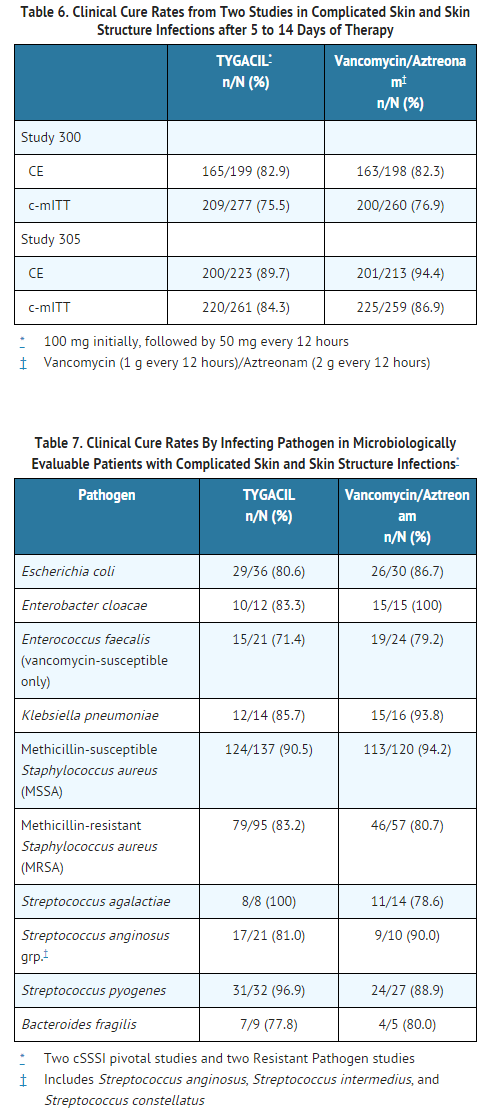
Complicated Intra-abdominal Infections
Tigecycline was evaluated in adults for the treatment of complicated intra-abdominal infections (cIAI) in two randomized, double-blind, active-controlled, multinational, multicenter studies (Studies 301 and 306). These studies compared tigecycline (100 mg intravenous initial dose followed by 50 mg every 12 hours) with imipenem/cilastatin (500 mg intravenous every 6 hours) for 5 to 14 days. Patients with complicated diagnoses including appendicitis, cholecystitis, diverticulitis, gastric/duodenal perforation, intra-abdominal abscess, perforation of intestine, and peritonitis were enrolled in the studies. The primary efficacy endpoint was the clinical response at the TOC visit for the co-primary populations of the microbiologically evaluable (ME) and the microbiologic modified intent-to-treat (m-mITT) patients. See TABLE 8. Clinical cure rates at TOC by pathogen in the microbiologically evaluable patients are presented in Table 9.
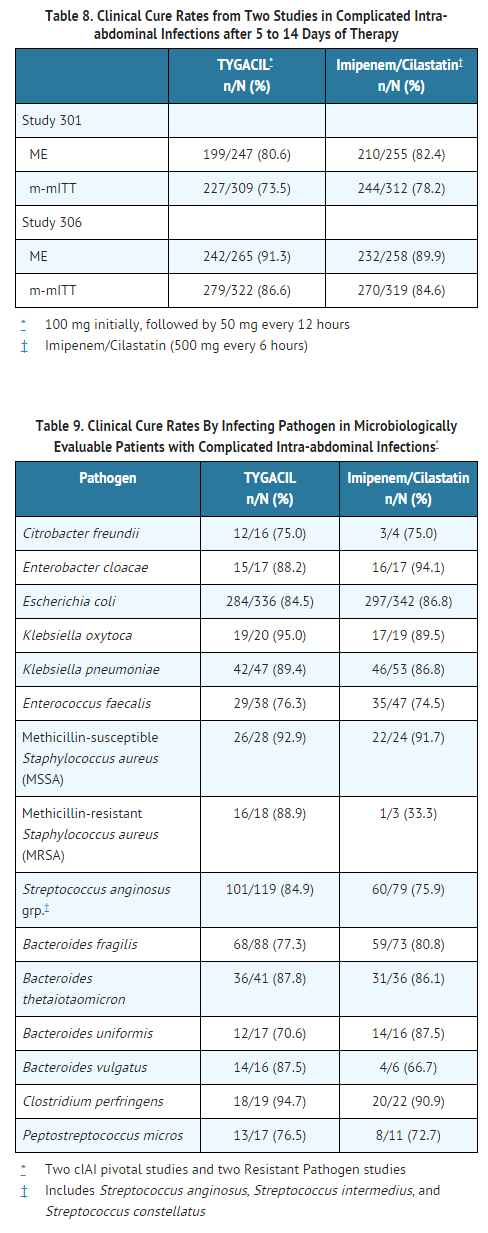
Community-Acquired Bacterial Pneumonia
Tigecycline was evaluated in adults for the treatment of community-acquired bacterial pneumonia (CABP) in two randomized, double-blind, active-controlled, multinational, multicenter studies (Studies 308 and 313). These studies compared tigecycline (100 mg intravenous initial dose followed by 50 mg every 12 hours) with levofloxacin (500 mg intravenous every 12 or 24 hours). In one study (Study 308), after at least 3 days of intravenous therapy, a switch to oral levofloxacin (500 mg daily) was permitted for both treatment arms. Total therapy was 7 to 14 days. Patients with community-acquired bacterial pneumonia who required hospitalization and intravenous therapy were enrolled in the studies. The primary efficacy endpoint was the clinical response at the test of cure (TOC) visit in the co-primary populations of the clinically evaluable (CE) and clinical modified intent-to-treat (c-mITT) patients. See TABLE 10. Clinical cure rates at TOC by pathogen in the microbiologically evaluable patients are presented in Table 11.
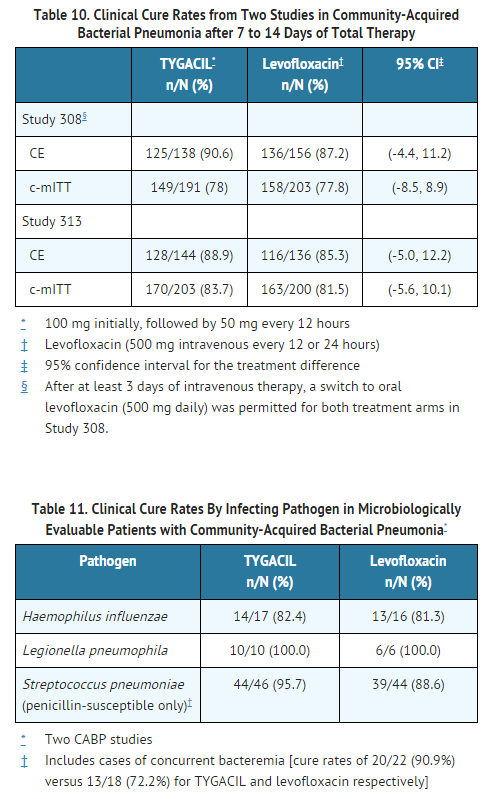
To further evaluate the treatment effect of tigecycline, a post-hoc analysis was conducted in CABP patients with a higher risk of mortality, for whom the treatment effect of antibiotics is supported by historical evidence. The higher-risk group included CABP patients from the two studies with any of the following factors:
- Age ≥50 years
- PSI score ≥3
- Streptococcus pneumoniae bacteremia
The results of this analysis are shown in Table 12. Age ≥50 was the most common risk factor in the higher-risk group.
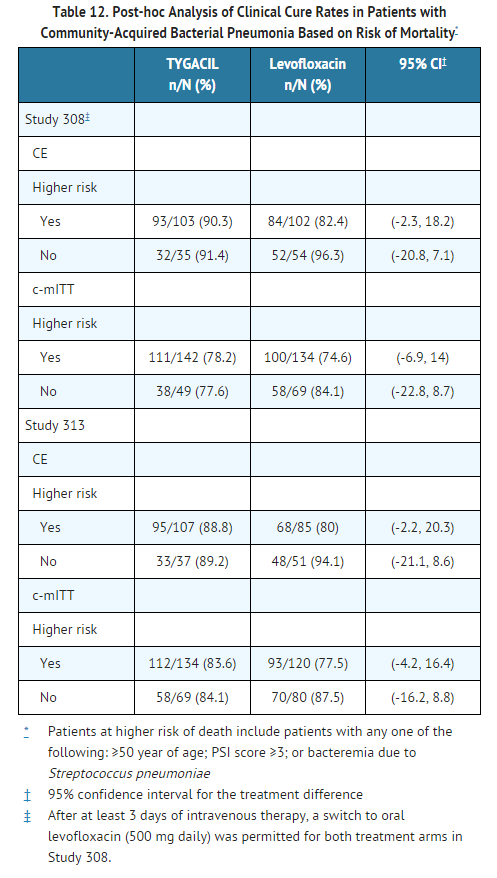
How Supplied
Tigecycline for injection is supplied in:
- Single-dose 5 mL glass vial
- Single-dose 10 mL glass vial
Each containing 50 mg tigecycline lyophilized powder for reconstitution.
Storage
Stored at 20° to 25°C (68° to 77°F)
Images
Drug Images
{{#ask: Page Name::Tigecycline |?Pill Name |?Drug Name |?Pill Ingred |?Pill Imprint |?Pill Dosage |?Pill Color |?Pill Shape |?Pill Size (mm) |?Pill Scoring |?NDC |?Drug Author |format=template |template=DrugPageImages |mainlabel=- |sort=Pill Name }}
Package and Label Display Panel

{{#ask: Label Page::Tigecycline |?Label Name |format=template |template=DrugLabelImages |mainlabel=- |sort=Label Page }}
Patient Counseling Information
- Patients should be counseled that antibacterial drugs including tigecycline should only be used to treat bacterial infections. They do not treat viral infections (e.g., the common cold). When tigecycline is prescribed to treat a bacterial infection, patients should be told that although it is common to feel better early in the course of therapy, the medication should be taken exactly as directed. Skipping doses or not completing the full course of therapy may (1) decrease the effectiveness of the immediate treatment and (2) increase the likelihood that bacteria will develop resistance and will not be treatable by tigecycline or other antibacterial drugs in the future.
- Diarrhea is a common problem caused by antibiotics which usually ends when the antibiotic is discontinued. Sometimes after starting treatment with antibiotics, patients can develop watery and bloody stools (with or without stomach cramps and fever) even as late as two or more months after having taken the last dose of the antibiotic. If this occurs, patients should contact their physician as soon as possible.
Precautions with Alcohol
Alcohol-Tigecycline interaction has not been established. Talk to your doctor about the effects of taking alcohol with this medication.
Brand Names
- Tygacil [1]
Look-Alike Drug Names
There is limited information regarding Tigecycline Look-Alike Drug Names in the drug label.
Drug Shortage Status
Price
References
The contents of this FDA label are provided by the National Library of Medicine.
{{#subobject:
|Label Page=Tigecycline |Label Name=Tigecycline 50 mg.png
}}